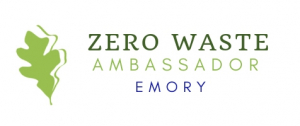
Upcycling, Recycling, and Downcycling: What I Didn’t Know About Off-Campus Recycling
By: Cooper Jannuzzo, M.S., EHI Office of Quality
Before my journey to zero waste, I was a recycling extremist. Everything plastic, glass, paper, and cardboard went into my at-home recycling bin. I was uneducated and thought that everything with a triangle was recyclable. Not only that, I thought that everything that went into my recycling bin turned into another product that was just as good, if not better. I had something terrible, destructive even, known as “wishful recycling”. My uneducated green efforts were leading me to contaminate my community’s recyclables – which can cause an entire truck load to turn into trash. My education started with a question, “is this plastic looking product recyclable if it doesn’t have a triangle”? That’s when I fell into a Google rabbit hole, exposing all the green crimes I committed.
What I learned? When recycling off campus, not everything is recyclable, and not everything will be upcycled. There are in fact three cycles: downcycle, recycle, and upcycle. Downcycling produces a lesser quality product from the original, recycling produces an equal quality product, and upcycling creates a higher quality product.
Let’s start with recycle, the most known of the three cycles. Recycling is not always what happens when you place something in your curbside recycling bin – despite its own name. Most of the plastics that are placed in your recycling bin are downcycled. For example, a recycling facility may provide plastic bottles to a flooring company so they can make carpet fiber. Recycling really refers to what happens to glass or aluminum, which can be re-melted and remanufactured infinitely. Moreover, not all plastics are accepted in your at-home recycling bin.

Referencing the triangles depicted above, here is where each of your plastics should go:
- Plastics 1 (PETE) and 2 (HDPE) can often be placed in your at-home recycling bin. These plastics are commonly used when making water bottles, milk containers, etc.
- Plastic 3 (PVC or V) usually cannot be placed in your at-home recycling bin. Check your local recycling plant, and when in doubt – throw it out (in the trash – if that wasn’t clear)
- Plastic 4 (LCPE) is commonly used to make grocery bags. These can be recycled at a drop off station at participating grocery stores. By no means should you place these in your at-home recycling bin.
- Plastic 5 (PP) is hard to melt, so it is commonly used to make takeout containers. Check your local recycling center, and when in doubt – throw it out, or better yet challenge yourself to purchase fewer items packaged in this material!
- Plastic 6 (PS) is also known as Styrofoam! It is not suitable for your at-home recycling bin, but there are drop off stations. If it is an egg carton, think Publix, right next to the grocery bag drop off station. If it isn’t an egg carton, think CHARM.
- Plastic 7 (Other) is either a combination of plastics, biodegradable, compostable, or something else entirely. It is not suitable for your at-home recycling bin.
So maybe your plastic bottle won’t become another plastic bottle and you can’t throw anything with a triangle into your at-home recycling bin. What’s the upside? Upcycling! See what I did there?
Upcycling is the best scenario for plastic. For example, TerraCycle® is a company that collects materials and creates upcycled products such as a purse made of someone’s old chip bags. This is a great option for plastics that would otherwise be considered trash. If you Google upcycling projects, you can find tons of DIY activities that will turn your trash into treasure!
If you are a recycling extremist like I once was, don’t fret. Educate yourself and start educating others on what products are accepted at your local recycling plant and what really happens to the plastic you send there!
Resources and great reads:
7 Things You Didn’t Know About Plastic (and Recycling). (2018, April 4). Retrieved November 12, 2020, from https://blog.nationalgeographic.org/2018/04/04/7-things-you-didnt-know-about-plastic-and-recycling/#:~:text=6.,or%20purity%20in%20the%20product.
The Violent Afterlife of a Recycled Plastic Bottle. (2015, December 4). Retrieved November 12, 2020, from https://www.theatlantic.com/technology/archive/2015/12/what-actually-happens-to-a-recycled-plastic-bottle/418326/
Recycling plastics – what the numbers mean + cheat sheet. (2009, August 1). Retrieved November 12, 2020, from https://www.greenlivingtips.com/articles/recycling-by-the-numbers.html

I also appreciate the in-depth explanation of downcycling, where recyclable materials end up with lower-quality products. It’s essential to be aware of this process and the potential limitations of traditional recycling methods. This article emphasizes the need for a more sustainable approach to waste management. As a student living off-campus, I now feel a greater responsibility to be more mindful of my recycling practices. I’ll make a conscious effort to upcycle whenever possible and be more selective about the items I recycle to avoid contributing to downcycling. It’s inspiring to know that I can play a role in reducing waste and contributing positively to the environment. Thank you for shedding light on this important topic and encouraging us to take action in our recycling habits. This knowledge will undoubtedly make a difference, not only in my personal choices but also in spreading awareness among my peers. Let’s work together to make a positive impact on our environment!